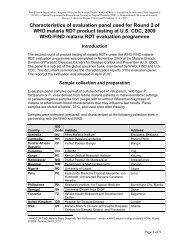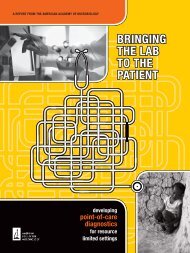Round 1 - Foundation for Innovative New Diagnostics
Round 1 - Foundation for Innovative New Diagnostics
Round 1 - Foundation for Innovative New Diagnostics
You also want an ePaper? Increase the reach of your titles
YUMPU automatically turns print PDFs into web optimized ePapers that Google loves.
Ease of use requirements will also vary, depending on<br />
the extent of training and the work environment of the<br />
end-users. Particularly in primary health care settings, the<br />
simpler the tests, the easier it will be to avoid errors in<br />
preparation and interpretation.<br />
1.4. Summary of outcomes<br />
• There is now a mechanism in place that allows<br />
laboratory-based evaluation of RDT per<strong>for</strong>mance in<br />
a standardized way to distinguish between well and<br />
poorly per<strong>for</strong>ming tests to in<strong>for</strong>m procurement and<br />
prioritization <strong>for</strong> entry into WHO prequalification and<br />
procurement schemes.<br />
• Several RDTs are available that demonstrated consistent<br />
detection of malaria at low parasite densities (200<br />
parasites/μl), have low false positive rates, are stable<br />
at tropical temperatures, are relatively easy to use, and<br />
can detect P. falciparum, P. vivax infections, or both.<br />
• Per<strong>for</strong>mance between products varied widely at low<br />
parasite density (200 parasites/μl); however, most<br />
products showed a high level of detection at 2000 or<br />
5000 parasites/μl.<br />
• Test per<strong>for</strong>mance varied between lots, and widely<br />
between similar products, confirming the advisability of<br />
lot-testing post purchase and prior to use in the field.<br />
• The results underscore the need <strong>for</strong> manufacturers<br />
to have adequate reference materials <strong>for</strong> product<br />
development and lot-release. The WHO-FIND malaria<br />
RDT evaluation programme, in collaboration with<br />
the CDC, will soon offer quality standard panels to<br />
manufacturers to assist in this process.<br />
1.5. Use of these Results<br />
Ultimately, it is imperative that procurement decisions<br />
based on these results take into consideration local<br />
conditions of malaria transmission and illness where the<br />
tests will be used (e.g. Plasmodium species, target antigen<br />
variation, parasite densities, climate). Procurement of RDTs<br />
must not occur without programmatic and infrastructure<br />
preparation <strong>for</strong> proper use, including supply chain<br />
management, training on test usage and disposal, and<br />
training on patient management in response to results.<br />
This report provides an algorithm to assist in this decisionmaking<br />
process (Annex 5).<br />
• P. falciparum tests targeting HRP2 antigen demonstrated<br />
the highest detection rates, but some tests targeting<br />
pLDH also exhibited high detection rates.<br />
2. Background<br />
In 2006, WHO estimated that 3.3 billion persons were<br />
at risk of acquiring malaria. Of these, 247 million were<br />
infected (86% in Africa) and nearly 1 million (mostly<br />
African children) died of the infection. In 2008, malaria<br />
was still endemic in 109 countries worldwide, 45 of them<br />
in Africa. WHO estimates that approximately 1.1 million<br />
persons were still dying of malaria that year (1).<br />
In the past decade, major new opportunities <strong>for</strong> the control<br />
of malaria have emerged, including implementation of<br />
long-lasting insecticidal nets, indoor residual spraying of<br />
insecticides and artemisinin-based combination therapy<br />
(ACT). These tools, in combination with increased coverage<br />
of malaria control programs, are likely to reduce the burden<br />
of malaria infection in countries where they are adequately<br />
implemented. In turn, the proportion of febrile episodes<br />
attributable to malaria is likely to decrease substantially.<br />
Despite WHO recommendations <strong>for</strong> laboratory-confirmed<br />
diagnosis of malaria infections 2 , diagnosis is often made<br />
2 With the exception of children under 5 years of age in areas of high<br />
transmission in whom treatment may be provided on the basis of a<br />
clinical diagnosis<br />
on clinical grounds (2). However, in most endemic areas<br />
malaria makes up a minority of 'malaria-like' febrile illness.<br />
Microscopy has been the cornerstone of diagnosis and<br />
remains the recommended method of malaria diagnosis<br />
at a central level, but the need <strong>for</strong> trained personnel,<br />
adequate reagents and equipment limit its availability and<br />
accessibility. Rapid, accurate and accessible diagnostic<br />
tools are becoming increasingly important, as programmes<br />
expand parasite-based diagnosis and the prevalence<br />
of malaria decreases. In recent years, rapid diagnostic<br />
tests (RDTs), which detect Plasmodium-specific antigens<br />
(proteins) in whole blood of infected people, have emerged<br />
as an attractive alternative to microscopy. Currently<br />
available RDTs come in various <strong>for</strong>mats (dipstick, cassette<br />
or card) and contain bound antibodies to specific antigens<br />
such as histidine-rich protein-2 (HRP2) (specific to P.<br />
falciparum), pan-specific or species-specific plasmodium<br />
lactate dehydrogenase (pLDH) or aldolase (specific to all<br />
the major Plasmodium species: P. falciparum, P. vivax, P.<br />
malariae, P. ovale (Figure 1).<br />
To be widely useful, a RDT must have high sensitivity to ensure<br />
all clinically-significant malaria infections are detected;<br />
high specificity to enable monitoring of low malaria<br />
prevalence and appropriate management of non-malarial<br />
fever; and high stability to allow transport and storage in<br />
ambient conditions in malaria-endemic areas. Published<br />
field trials of RDTs show high variability in per<strong>for</strong>mance,<br />
likely due to inadequate quality of manufacture, incorrect<br />
storage and handling, poor preparation and interpretation,<br />
Malaria Rapid Diagnostic Test Per<strong>for</strong>mance – Results of WHO product testing of malaria RDTs: <strong>Round</strong> 1 (2008)<br />
3


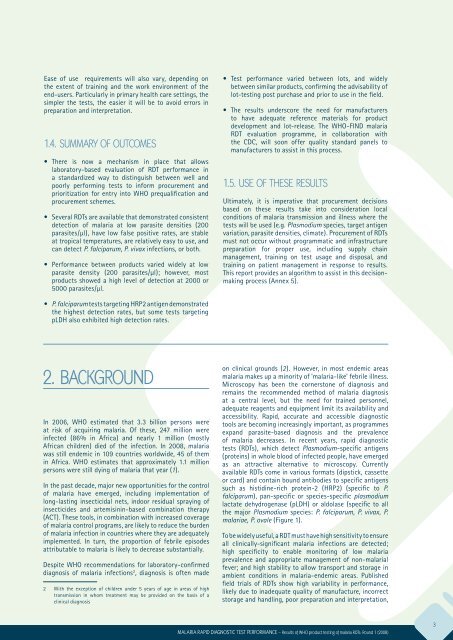

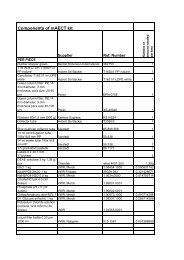
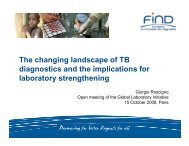
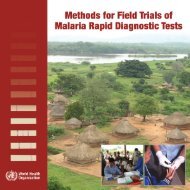
![Download in English [pdf 2Mb] - Foundation for Innovative New ...](https://img.yumpu.com/49580359/1/184x260/download-in-english-pdf-2mb-foundation-for-innovative-new-.jpg?quality=85)

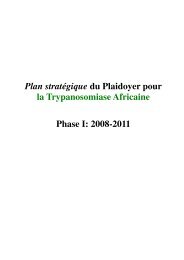
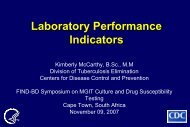
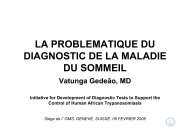
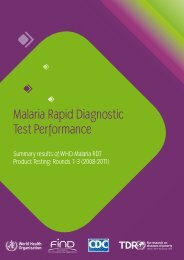
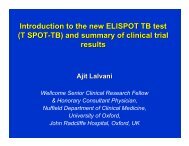
![New laboratory diagnostic tools for tuberculosis control [.pdf]](https://img.yumpu.com/43339906/1/190x135/new-laboratory-diagnostic-tools-for-tuberculosis-control-pdf.jpg?quality=85)
